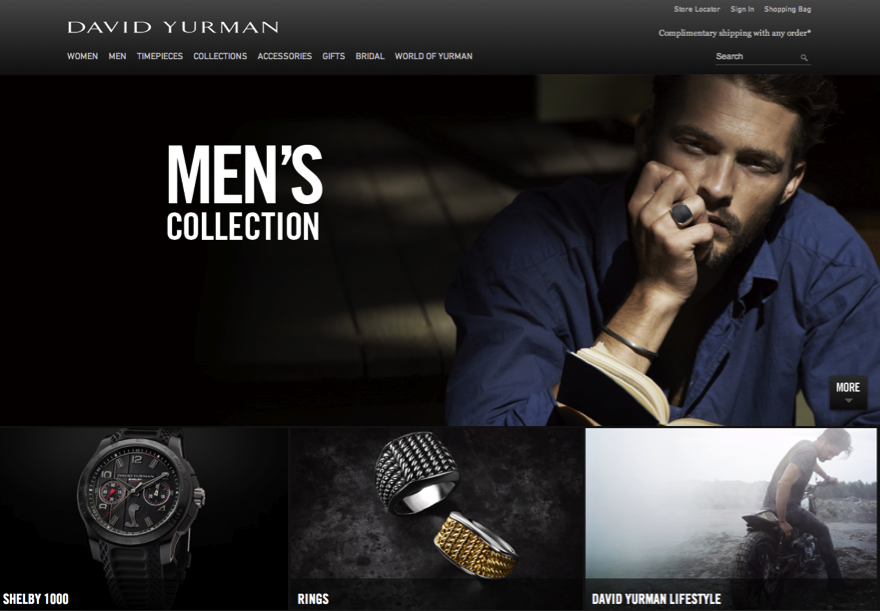
Rony Zeidan, founder & chief creative officer of RO New York Inc, investigates the relationship between on & off-line retail, as luxury brands harness the power of e-Commerce
Rony Zeidan, founder & chief creative officer of RO New York Inc, investigates the relationship between on & off-line retail, as luxury brands harness the power of e-Commerce.
The past decade has witnessed a trend of luxury brands jumping on the bandwagon of online retailing, what seemed to be the cure to retail stagnation, or better yet ‘the’ future of retailing.
Brands like David Yurman (2010), Cartier (2010), Tiffany & Co (1999), Van Cleef & Arpels (2012), Chopard (2012) have put a lot of their marketing efforts on promoting their e-commerce presence by driving more traffic every quarter, and engaging their customers in rich online experiences.
From Facebook apps promoting exclusive product access, to one-of-kind brand lifestyle sceneries. From optimised mobile sites allowing the active top tier clientele a simplified speedy browsing capability on their devices, to ‘traditional’ digital advertising techniques.
“ The online experience is very much tied to the traditional experience, calling upon the senses of touch & sight ”
What might not have been obvious at first, is that the online experience – at the high-end echelon – is very much tied to the traditional experience, calling upon the senses of touch and sight. For example, investing in a $55,000 L.U.C, Chopard watch is backed by several factors:
1. Familiarity with the brand product
2. Trust in quality, detail, and craftsmanship
3. Knowledge and facts
4. The sensory experience
The e-Commerce platform allows for an in-depth experience of the product based on a highly visual and informative stimulation. Micro-detail shots that can be viewed at a grand scale online, videos that explore the mesmerising way a watch comes to, and the ability to browse alternate styles with a click of the button, allow you the ease of viewing your products and making a self-motivated decision on a purchase.

All the luxuries of online shopping might not trigger the consumer to click the ‘buy’ button, but can easily create a desire that translates into a store purchase once the selected product is tried on. That’s the one missing link for holy grail of e-commerce shopping, and remains to be explored in the near future with technology’s evolution.
In the meantime, the brick and mortar stores can fulfil that human need of touch and feel, and thus seal the deal on a sale. There comes the dependency between online and the traditional retail environment.
When purchasing a commodity product, it is easy to click the ‘buy’ button, because the risks of not being fully satisfied and having to incur the hassle of a return is not financially hefty. Nonetheless, the luxury world plays on a different chord. The level of customer service, and experience is key. The more info available, the more the success rate in sales.
“ Online shopping might not result in a purchase, but can create desire that translates into a store purchase ”
Let’s take Tiffany’s, a leader in the online sales arena, with 70% of their business executed online. Testament that time and patience will help increase online sales significantly, and establish a loyalty and trust for the brand by the consumers.
Tiffany’s first delved into the online arena in 1999, way ahead of the game of a lot of luxury brands, at a moment when LVMH was testing the virtual grounds with eluxury.com (now nowness.com). The discovery was fantastic in the US: a country so big, with untapped consumers in Middle America who do not have access to the latest designer and luxury labels; an instant success.
Since then, the online market has witnessed the influx of all sorts of brands and traditional brick and mortar retailers dive into the virtual arena. Early adopters have faired the best, simply because they’ve had a jump start on customer acquisition.

After a decade of e-commerce development, we now are witnessing a reverse motion. Brands who were opting for a reduction of brick and mortar presence, while capitalising on a major online expansion, are realising that consumer habits have changed and are versatile.
A window shopping experience on Madison Avenue, can easily result in an online purchase for David Yurman, and an online exploration and data gathering on us.chopard.com, can easily result in a purchase in store.
This trend crosses over many categories of style, with companies such as Warby Parker for example. An accessible stylish eyewear company, founded on the principle of affordable style with a smart online experience, has modified it’s focus from strictly an online presence to opening a flagship store in Soho to capitalise on the touch and feel customer experience.
“ After a decade of e-commerce development, we now are witnessing a reverse motion ”
Smaller luxury brands such as ‘title of work’, a luxury men’s accessory label inspired by the art world, are experiencing the same trends. Customers browse products online, and then execute purchases at Barney’s or Neiman Marcus, and vice versa.
The retail experience has become seamless, and thus again confirming that brands need to continuously nurture both online and offline presence, and interact with their consumer accordingly, in different ways to constantly reflect, newness and excitement, while remaining on brand, focused in messaging, truthful, and compelling.
To further investigate Retailing on Luxury Society, we invite you to explore the related materials as follows:
- Single-brand Retail Remains a Key Driver of Luxury Growth
- China’s Luxury E-Commerce Market Heads In A New Direction

